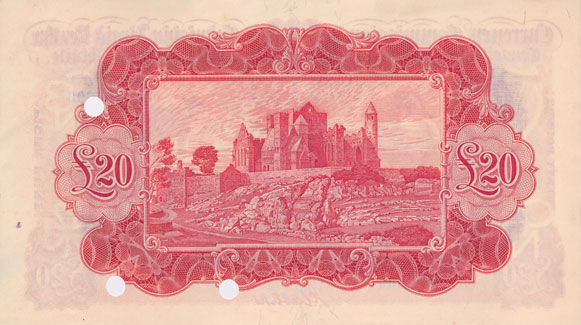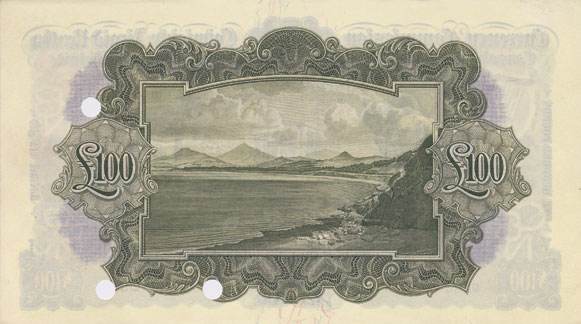This [electronic] version (2015) www.irishpapermoney.com/forum/viewforum.php?f=22 Numismatic Articles and Papers / Occasional Papers on Irish Paper Money
Recommended Citation
Mac Devitt, M. (2015). The ‘Ploughman’ Consolidated Bank Note issue of the Irish Free State, 1929–1941. Higher denomination notes and Specimens. [Electronic version]. Accessed [insert date], from irishpapermoney.com/forum/ Occasional Papers on Irish Paper Money:
www. irishpapermoney.com/forum/viewtopic.php?f=22&t=326
The ‘Ploughman’ Consolidated Bank Note issue of the Irish Free State, 1929–1941
Higher denomination notes and Specimens
By Martan Mac Devitt
All of the Ploughman £20, £50 and £100 notes have been redeemed, leaving no live notes in circulation. Thus, only Specimens of these denominations are available for collectors. There are several types of Specimen note in this series.
The Consolidated Bank Note (CBN) series is, in terms of banknote collecting, somewhat analogous in era, value, and relative rarity of denominations to notes of the Palestine Currency Board of the same era. In both note issues, £20, £50 and £100 notes are rarely offered. In the case of the Ploughman notes, only Specimens are available.
Two banknote issues
Ireland has always been a country of conservative compromise. The question of how to create a currency for the newly created Irish Free State without upsetting the economic well-being or the status quo of the stable banking system was addressed by what might be considered a number of half-measures: a Currency Commission instead of a Central Bank; Linkage to Sterling—the stable circulating currency in Ireland since 1826—instead of a new independent currency unit; the choice of two parallel banknote issues, Legal Tender Notes (LTN, A Series, Lady Lavery), a government issue, and Consolidated Bank Notes (CBN, Ploughman notes) issued by the commercial banks operating within the state. The two banknote issues which evolved were very similar in colour, though quite different in their design, purpose, and circulation statistics.
Issued notes
CBN entered circulation on 6 May 1929. The £1, £5 and £10 notes all bore the same date, 6.5.29. Currency Commission records indicate that the total amount in circulation on 11 May 1929 was £2,529,900. Higher denomination notes — £20, £50, and £100 — all bore the date 10.6.29. They entered circulation on the week ending 31 Aug 1929, with a total amount of £3,500 going into circulation then. This had reached £7,000 by 28 Sept 1929, and began to decline steadily thereafter. The amount of higher denomination CBN in circulation was minuscule compared to that of the lower denominations, generally around 0.001%–0.002% (See Table 4 and Table 5), and was also a fraction of the LTN higher denomination note circulation. At the same time, CBN £1 and £5 notes accounted for a substantial proportion of the total circulation of these denominations. Thus, the usage of CBN higher denomination notes was extremely low, and the denominations were probably not necessary at all. This is supported by the fact that all the notes were fully redeemed well before the issue itself ended, thus leaving only Specimen and proof notes available to collectors. Examples of issued Munster & Leinster Bank £20, £50, and £100 notes are illustrated in The Banknote Yearbook, and in Irish Banknotes (2009).
Prefixes
The serial numbers on each banknote consists of a double digit prefix number + Bank Key Letter + Denomination Identifier Letter + six digit number running from 000001 to 100000 per prefix. Denomination letters are as follows: £1, A; £5, K; £10, T; £20, X; £50, Y; £100, Z. The denomination letters used on CBN higher denomination notes are the same as those used on LTN.
The Bank Key Letter corresponded to the first letter of the name of the bank, in alphabetical order. If a letter was already taken, then the next free letter in the bank’s name was used. Thus, as N had already been allocated to the National Bank, the Northern Bank Key Letter fell on O, being the second letter of the word ‘Northern’. The Northern Key Letter was changed to E after the first printage, likely because O resembled the numeral zero. E was the next free letter in the word ‘Northern’. Very logical, except that T comes before E! The likely explanation for T not being used is that T had already been assigned to the Ten Pound denomination, and thus couldn’t be used. This rule breaks down however, when Bank of Ireland £1 notes eached 99BA and the denomination letter changed to B, already in use as the bank’s Key Letter.
Printage figures and issue of £20, £50, and £100 notes
£1,000,000 was allocated to the £20, £50, and £100 notes by the Currency Commission (Moynahan, 1975). Information is not currently available as to the exact breakdown by denomination of this sum. A reasonable speculative estimate is presented in Table 1. Actual printage figures for Legal Tender Notes (CBI) are given for comparison.
Table 1: Printage figures of £20, £50, £100 Consolidated Bank Notes (estimated), with Legal Tender Notes (actual) for comparison.

At some point, part of the allocation for the higher denomination notes may have been reallocated to lower denominations, as the latter exceeded £5,000,000 in circulation in February, 1937 (CBI). Pratschke (1969) notes that the Currency Commission did alter individual bank quotas from 1 Oct 1931. Total CBN circulation peaked at £5,195,137 on the week ending 17 Oct 1942, and began to decline steadily thereafter.
It is known that 4000 Munster and Leinster Bank £20 notes (£80,000) were printed (Mc Devitt, 1999); and 3000 Northern Bank £20 notes (£60,000) (Young, 1972). It is unlikely that the CBN printages would have exceeded those of the LTN for any denomination.
Table 2 shows which banks issued the various denominations. It is interesting to note that the National Bank and the Provincial Bank, both major banks, chose not to issue some denominations and that the Royal, one of the smaller banks, chose to issue all denominations.
Table 2: Higher denominations issued by each of the Associated Banks. (CBI).

Circulation of Consolidated Bank notes
Higher denomination £20, £50, and £100 notes had a very low circulation as a percentage of the total CBN issue. Detailed data for the circulation of Bank of Ireland notes is available (BoI), as well as data on the totals in circulation for all the banks (CBI). These two sets of data are compared in Table 3.
Table 4 presents a comparison of the circulation of CBN with that of LTN which entered circulation on 10 Sept 1928, rising steadily to £7,435,000 by 4 May 1929 (Brennan, 1931). It is interesting to note that CBN rapidly grew to make up a large proportion of the £1 and £5 note circulation in the State. By 1934, CBN accounted for around 40% of the total note circulation (Honohan 1994), with the number of CBN £1 notes in use exceeding that of LTN. Ploughman notes would have been very common in this era, as the main denominations in everyday use were 10 Shilling and £1 notes. The other interesting fact is that the CBN circulation of higher denomination notes remained a tiny fraction of that of the LTN higher denomination notes. It should also be noted that LTN 10 Shilling notes were circulating in similar numbers to those of the LTN £1 notes, and that the Old Notes (The Currency Commission term for pre-partition all-Ireland issues) of the Associated Banks (those issuing CBN) were also still circulating in significant quantities.
Table 3: Bank of Ireland CBN in circulation August, 1929.
On 31 August 1929 the Bank of Ireland had the following amounts of notes in circulation:

Table 4: Comparison of the circulation of Higher Denomination Legal Tender Notes and Consolidated Bank Notes.
(Sources: BoI, CBI).
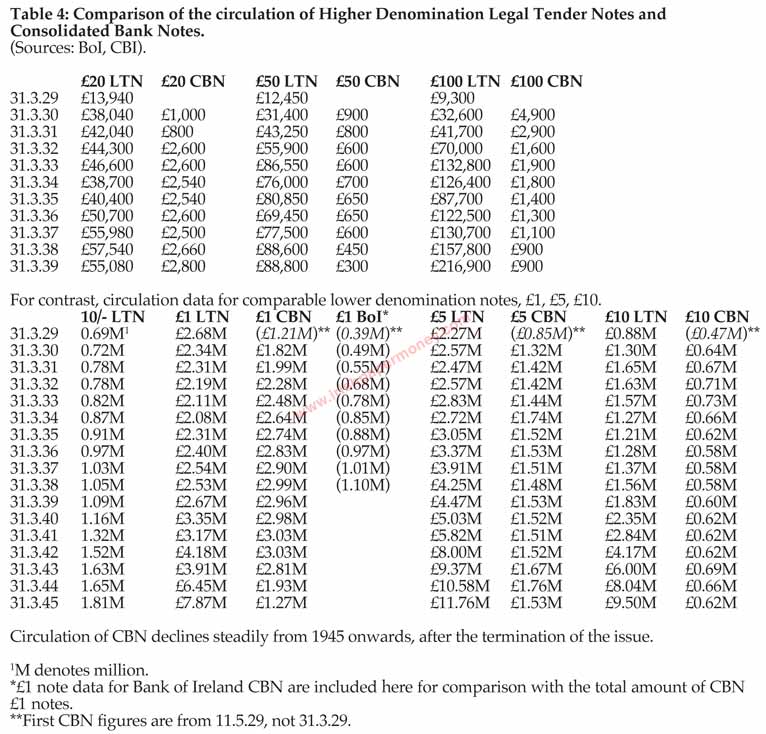
Circulation of CBN declines steadily from 1945 onwards, after the termination of the issue.
1M denotes million.
*£1 note data for Bank of Ireland CBN are included here for comparison with the total amount of CBN £1 notes.
**First CBN figures are from 11.5.29, not 31.3.29.
The quantity of Old Notes still in circulation was a factor which influenced the amount of CBN in circulation for those banks which had previously issued Old Notes prior to 6 May 1929. With the on-going withdrawal of older issues, Old Notes outstanding which were not deemed to be Consolidated Notes reached zero on the following dates for each bank (CBI): National, 19.7.30; Northern, 24.5.30; Provincial, 17.5.30; Ulster, 26.7.30; Bank of Ireland, 9.1.32. Thereafter, as outstanding Old Notes were redeemed, the banks could issue CBN in place of them, and the total CBN in circulation for each of the five banks concerned began to rise. This was not reflected by any increase of higher denomination notes in circulation. Indeed, records show that Bank of Ireland was increasing its issue of £1 and £5 notes in place of these Old Notes and in place of its ever declining circulation of CBN £10, £20, £50, and £100 notes. The last outstanding Bank of Ireland £20, number 01BX 000027 was redeemed during the week ending 25 Sept 1936 (BoI). No further £20 notes were issued by this bank. The bank’s remaining £50 and £100 notes were cancelled on the week ending 30.6.37 and 22.4.39 respectively. Notes of other banks continued in circulation in very small quantities, as can be seen in Table 5.
Table 5 compares the CBN issued by Bank of Ireland with the total numbers of CBN in circulation. Several facts are evident. £20 notes were issued in quantity by other banks. Bank of Ireland was initially the major issuer of £50 and £100 notes, though other banks began to issue them towards the end of 1931. These notes circulated in minuscule quantities, tens of notes. Total circulation peaked at £8,250 at the end of May, 1932. This broke down as: £5600 in £20 (280 notes); £550 in £50 (11 notes); £2100 in £100 (21 notes). By the end of March 1953 there were fifteen £20 notes, one £50 note, and two £100 notes left in circulation, out of a total CBN circulation of £699,380.
Table 5: Actual value of Consolidated Bank Notes in circulation.
Comparison of Bank of Ireland circulation at a given date against total circulation (in brackets). Dates are where a significant change happened for one of the denominations. Gaps indicate no net change.
The total value of the high denomination notes in circulation is given as a percentage of the total of all CBN on certain dates in the far right hand column.
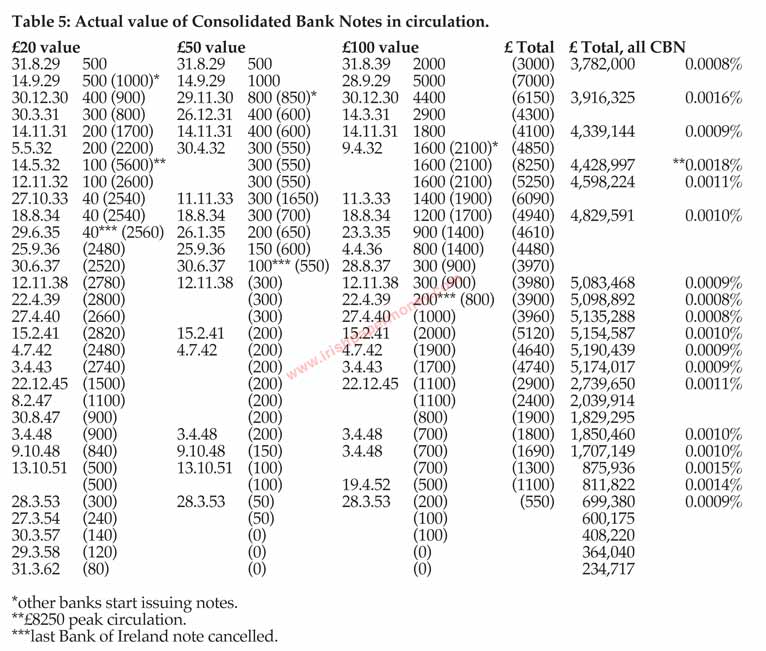
*other banks start issuing notes.
**£8250 peak circulation.
***last Bank of Ireland note cancelled.
Availability of £20, £50, and £100 notes for collectors
Given the circulation levels of Ploughman £20, £50, and £100 notes, it is unsurprising that there are no issued notes left outstanding for collectors. This focuses attention on Specimen notes for those collectors who wish to have an example of one of these denominations. CBN Specimens are generally rare. It is the higher denominations which are preferentially sought.
Specimen notes
For collecting purposes, only Specimens and proofs of the higher denomination notes are available. They can be grouped into several categories (Table 6). Three basic types of Specimen note have been seen so far. All notes seen are overstamped “Specimen” in Copperplate Typeface on the face only. The angle of the “Specimen” text varies slightly between the three types, and varies in placement on the pre-production proofs. On Type C Specimen notes, the placement of the De La Rue stamp also varies between notes of the same denomination. Table 6 lists the colours of the various types of Specimen notes. It is somewhat ironic that all Specimens of these Types bear the Bank of Ireland title, one of the banks that made least usage of the higher denomination notes in circulation.
The higher denomination Specimens command a much higher price than lower denomination Specimens, and an issued AU grade note would generally fetch a higher price than a Specimen, especially a £10 note. CBN Specimens have turned up occasionally in the market over the past thirty years. There has been no significant price differential between Specimens of Types A or C. However, it appears that Higher denomination specimens are extant in similar quantities and there is a general trend for £50 and £100 notes to fetch higher prices at auction than £20 notes.
Type A. Official Currency Commission Specimens printed on both sides, ca 1929, in the colours of the issued notes on watermarked paper containing the thread fibre security feature found on all issued notes. The Specimens are punched through with three holes. They are printed with the Bank of Ireland title and bear the signatures of Joseph Brennan and J. A. Gargan. Fictitious serial numbers, 00ZK 000000 and date 5.9.78 are on each note. These Specimens are all uniform, and were produced with the first printing of the banknote issue, ca 1929. The Specimens were printed for the puropse of familiarising banks with the new note issue, and with that in mind Specimen sets were circulated on loan from the Currency Commission to bank branches. All official Specimens remain the property of the Central Bank of Ireland, unless provenanced otherwise. There are a few sets of these about. Denominations: £1, £5, £10, £20, £50, £100.
Type B. Pre-production proofs, ca 1929 in various colour combinations. These have been seen printed uniface on both paper and card, without a Bank title, second signature, or date and serial number (Fig 2.). They were printed in various colour combinations of underprint and overprint. The colour combinations of these proofs differ to those of Types A and C. A Ten Shilling note design was also prepared, but not proceeded with (Mac Devitt). Denominations: 10/-, £1, £5, £10, £20, £50, £100.
Type C. Non-production TDLR Specimens printed on both sides on unwatermarked paper in colour combinations not used for the banknote issue. TDLR Specimens are also missing the thread fibre security feature standard on the issued notes. They are printed with the Bank of Ireland title and bear the signatures of Joseph Brennan and J. A. Gargan. Fictitious serial numbers, 00ZK 000000 and date 5.9.78 are on each note. Most notes have a De La Rue & Co LTD stamp on the bottom right. These Specimens were for inclusion in TDLR Specimen books. All recorded TDLR Specimens are of the same colour combinations for each denomination. These Specimens are often referred to as colour trials, printed ca 1927, but there is no data or references cited to support this. They have also been referred to as sample Specimens, printed in the 1930s, also uncited. The latter would seem to be more plausible as it was a standard practice of the printers at the time. Generally, De La Rue sets of CBN found in Specimen books comprise 5 denominations, excluding the £1 note. Denominations: £1, £5, £10, £20, £50, £100.
There are several subvarieties of the Type C TDLR Specimens recorded so far, as follows:
C1. Numbered in serif type in three digits, set after the sans-serif text ‘Specimen No.’ (Fig C1).
C2. Unnumbered, but with the sans-serif text ‘Specimen No.’ (Fig C2).
C3. Numbered by hand, and with two TDLR stamps, on the top left and bottom right (Fig C3).
C4. Unnumbered, without TDLR overprint (Fig C4).
C5. As C4, but punch hole in Second signature, Gargan.
Colours and designs
It is interesting to note that despite the colour trials being done in various colours, the final colour scheme reflected that of the Legal Tender Notes, which were to be introduced in 1928. This may reflect a desire to maintain a similarity between each denomination of the CBN and LTN issues. Indeed, Brennan (1931 p23) notes the delicate situation involved in tampering with the status quo of the currency circulation in the Irish Free State. This may have influenced a conservative approach to the general colour scheme of both the LTN and CBN note designs.
Table 6: Predominant colours used on each denomination of the three Types of Consolidated Bank Note specimens.

The reverse engravings of each denomination depict scenes from Ireland.
£1 The Custom House, Dublin, east of O’Connell Street. The building opened in 1791.
£5 St. Patrick’s bridge across the river Lee, Cork city, opened in 1861.
£10 Close up view of the Currency Commission Building at Foster Place, Dublin, near College Green. The building dates from 1811.
£20 Panoramic view of the old ruined Monastery on the Rock of Cashel, Co. Tipperary. The oldest parts date from ca 1100.
£50 A View of Croagh Patrick Mountain in Co. Mayo.
£100 A Broad view of Killiney bay, Co. Dublin.
Recorded Specimen notes
The Ploughman Scan Survey has recorded all Specimen notes as they have turned up. A group of Type C1 Specimen sets began to appear around 1992, mostly carelessly removed from Specimen books, often damaging the notes in the process. Occasionally the notes are still attached to pages, or have been unmounted without an attempt to remove the glue by means of scraping it off or with the aid of a liquid. Sets and parts of sets numbered in the region from 204 to 221 have been seen (See Table 7a). Given that all observed Type C Specimens were mounted, the possibility is that there are considerably more notes yet to be recorded, good news for collectors who are looking to add a £20, £50, or £100 to their set.
Table 7a: Consolidated Bank Note Specimens recorded.
This listing is of verified individual notes, available to collectors, mostly seen in UK auctions. It excludes notes in museums and archives, which are unlikely to become available to collectors.

Table 7b: Type C1 numbers recorded. Most notes are unused, but with mounting removal damage.
£5, £10, £20, £50 Notes numbered 206 were not damaged whilst being unmounted.

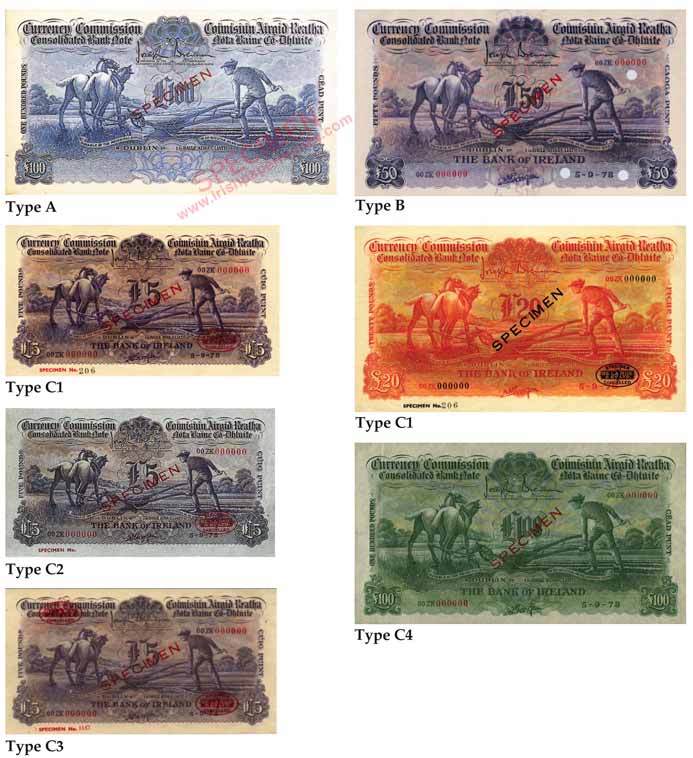
Fig 1. The various different types of Ploughman Specimen notes.
Comments about this article
Correspondence and comments to the author are welcome by email or by posting on www.irishpapermoney.com/forum where more information on Irish Banknotes is also available. Images of all the known denominations of each type of CBN Specimen may be viewed on the Consolidated Banknotes Pages.
Future Articles
A side-effect of the PSS data set is that a good overview of the grades of the extant population of CBN is now available, as well as a census of the notes which have been damaged by cleaning. The survey is also longitudinal to some degree, in that many of the notes recorded have turned up several times in the course of the survey. This will be the subject of a future article.
References
Bank of Ireland Archives. Abbreviated to BoI in the text.
Brennan, J. (1931). The Currency System of the Irish Free State. Journal of the Statistical & Social Inquiry Society of Ireland, Oct. 1931, Session 84, p23–P26.
Central Bank of Ireland. Abbreviated to CBI in the text.
Fitzwilliam Museum Library, University of Cambridge, UK.
Honohan, P. (1997). Currency Board or Central Bank? Lessons from the Irish Pound’s Link with Sterling, 1928-79. BNL Quarterly Review, 200., March, 1997.
Mac Devitt, M. (1999). Irish Banknotes. Irish Government Paper Money From 1928. Seachran & Whytes.
Mac Devitt, M. (2002). Irish Paper Money 1783 - 2001. 1st Edition. Seachran.
Mac Devitt, M. (2009). Irish Banknotes. Irish Government Paper Money From 1928. Updates. Seachran.
Moynihan, M. (1975) Currency and Central Banking in Ireland 1922–60, Gill & MacMillan in association with the Central Bank of Ireland.
Pratschke, J.L., ‘The Establishing of the Irish Pound: A Backward Glance’, Economic and Social Review, Vol. 1, October 1969, pp. 51-75. p57.
Young, D. (1977). Guide to the Currency of Ireland–Consolidated Bank Notes 1929–1941. Stagecast. Abbreviated to GCI in the text.


